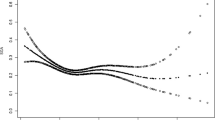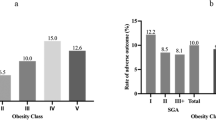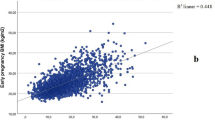Abstract
Objective
Women with obesity have an increased risk of pregnancy complications. Although complications generally present in the second and third trimester of pregnancy, most of them develop in the periconception period. Moreover, fetal sex also impacts pregnancy course and outcome. Therefore, our aim is to study (sex-specific) associations between periconceptional maternal body mass index (BMI) and embryonic growth and morphological development.
Methods
A total of 884 women with singleton pregnancies were selected from the Rotterdam Periconception Cohort, comprising 15 women with underweight, 483 with normal weight, 231 with overweight and 155 with obesity. Longitudinal three-dimensional ultrasound examinations were performed at 7, 9, and 11 weeks of gestation for offline measurements of crown-rump length (CRL), embryonic volume (EV), and Carnegie stages. Analyses were adjusted for maternal age, parity, ethnicity, education, and periconceptional lifestyle.
Results
A negative trend was observed for embryos of women with obesity (βEV −0.03, p = 0.086), whereas embryonic growth and developmental trajectories in women with overweight were comparable to those with normal weight. Maternal underweight was associated with faster morphological development (βCarnegie 0.78, p = 0.004). After stratification for fetal sex, it was demonstrated that female embryos of underweight women grow and morphologically develop faster than those of normal weight women (βEV 0.13, p = 0.008; βCarnegie 1.39, p < 0.001), whereas female embryos of women with obesity grow slower (βEV −0.05, p = 0.027).
Conclusion
We found that periconceptional maternal underweight is associated with faster embryonic growth, especially in females. In contrast, female embryos of women with obesity grow slower than female embryos of women with normal weight. This may be the result of altered female adaptation to the postnatal environment. Future research should focus on strategies for optimizing preconceptional maternal weight, to reduce BMI-related pregnancy complications and improve the health of future generations.
This is a preview of subscription content, access via your institution
Access options
Subscribe to this journal
Receive 12 print issues and online access
$259.00 per year
only $21.58 per issue
Buy this article
- Purchase on Springer Link
- Instant access to full article PDF
Prices may be subject to local taxes which are calculated during checkout


Similar content being viewed by others
Code availability
The code underlying this article can be shared on reasonable request to the corresponding author.
References
Mokdad AH, Ford ES, Bowman BA, Dietz WH, Vinicor F, Bales VS, et al. Prevalence of obesity, diabetes, and obesity-related health risk factors, 2001. JAMA. 2003;289:76–9.
Wright SM, Aronne LJ. Causes of obesity. Abdom Imaging. 2012;37:730–2.
Redinger RN. The pathophysiology of obesity and its clinical manifestations. Gastroenterol Hepatol. 2007;3:856–63.
Double burden of malnutrition. In: World Health Organization, https://www.who.int/news-room/factsheets/detail/malnutrition. Accessed on 1 July 2020.
Guelinckx I, Devlieger R, Beckers K, Vansant G. Maternal obesity: pregnancy complications, gestational weight gain and nutrition. Obes Rev. 2008;9:140–50.
Metwally M, Li TC, Ledger WL. The impact of obesity on female reproductive function. Obes Rev. 2007;8:515–23.
van der Steeg JW, Steures P, Eijkemans MJ, Habbema JD, Hompes PG, Burggraaff JM, et al. Obesity affects spontaneous pregnancy chances in subfertile, ovulatory women. Hum Reprod. 2008;23:324–8.
Aune D, Saugstad OD, Henriksen T, Tonstad S. Maternal body mass index and the risk of fetal death, stillbirth, and infant death: a systematic review and meta-analysis. JAMA. 2014;311:1536–46.
Di Renzo GC, Rosati A, Sarti RD, Cruciani L, Cutuli AM. Does fetal sex affect pregnancy outcome? Gend Med. 2007;4:19–30.
de Zegher F, Devlieger H, Eeckels R. Fetal growth: boys before girls. Horm Res. 1999;51:258–9.
Steegers-Theunissen RP, Twigt J, Pestinger V, Sinclair KD. The periconceptional period, reproduction and long-term health of offspring: the importance of one-carbon metabolism. Hum Reprod Update. 2013;19:640–55.
Power C, Atherton K, Thomas C. Maternal smoking in pregnancy, adult adiposity and other risk factors for cardiovascular disease. Atherosclerosis. 2010;211:643–8.
Reynolds RM, Allan KM, Raja EA, Bhattacharya S, McNeill G, Hannaford PC, et al. Maternal obesity during pregnancy and premature mortality from cardiovascular event in adult offspring: follow-up of 1 323 275 person years. BMJ. 2013;347:f4539.
Metwally M, Ong KJ, Ledger WL, Li TC. Does high body mass index increase the risk of miscarriage after spontaneous and assisted conception? A meta-analysis of the evidence. Fertil Steril. 2008;90:714–26.
Blomberg MI, Kallen B. Maternal obesity and morbid obesity: the risk for birth defects in the offspring. Birth Defects Res A Clin Mol Teratol. 2010;88:35–40.
Gordon GH, Antony KM, Sampene E, Iruretagoyena JI. Maternal obesity is not associated with increased crown-rump length in first-trimester ultrasounds of singleton gestations. J Matern Fetal Neonatal Med. 2019;32:2393–9.
Thagaard IN, Krebs L, Holm JC, Christiansen M, Møller H, Lange T, et al. The effect of obesity on early fetal growth and pregnancy duration: a cohort study. J Matern Fetal Neonatal Med. 2018;31:2941–6.
Rousian M, Koning AH, van Oppenraaij RH, Hop WC, Verwoerd-Dikkeboom CM, van der Spek PJ, et al. An innovative virtual reality technique for automated human embryonic volume measurements. Hum Reprod. 2010;25:2210–6.
Verwoerd-Dikkeboom CM, Koning AH, Hop WC, Rousian M, Van Der Spek PJ, Exalto N, et al. Reliability of three-dimensional sonographic measurements in early pregnancy using virtual reality. Ultrasound Obstet Gynecol. 2008;32:910–6.
Verwoerd-Dikkeboom CM, Koning AH, van der Spek PJ, Exalto N, Steegers EA. Embryonic staging using a 3D virtual reality system. Hum Reprod. 2008;23:1479–84.
Steegers-Theunissen RP, Verheijden-Paulissen JJ, van Uitert EM, Wildhagen MF, Exalto N, Koning AH. et al. Cohort Profile: The Rotterdam Periconceptional Cohort (Predict Study). Int J Epidemiol. 2016;45:374–81.
van Uitert EM, Exalto N, Burton GJ, Willemsen SP, Koning AH, Eilers PH, et al. Human embryonic growth trajectories and associations with fetal growth and birthweight. Hum Reprod. 2013;28:1753–61.
Rousian M, Koning AH, van der Spek PJ, Steegers EA, Exalto N. Virtual reality for embryonic measurements requiring depth perception. Fertil Steril. 2011;95:773–4.
O’Rahilly R, Muller F. Developmental stages in human embryos: revised and new measurements. Cells Tissues Organs. 2010;192:73–84.
Gaillard R, de Ridder MA, Verburg BO, Witteman JC, Mackenbach JP, Moll HA, et al. Individually customised fetal weight charts derived from ultrasound measurements: the Generation R Study. Eur J Epidemiol. 2011;26:919–26.
Papageorghiou AT, Ohuma EO, Altman DG, Todros T, Cheikh Ismail L, Lambert A, et al. International standards for fetal growth based on serial ultrasound measurements: the Fetal Growth Longitudinal Study of the INTERGROWTH-21st Project. Lancet. 2014;384:869–79.
Hoftiezer L, Hof MHP, Dijs-Elsinga J, Hogeveen M, Hukkelhoven C, van Lingen RA. From population reference to national standard: new and improved birthweight charts. Am J Obstet Gynecol. 2019;220:e17.
Yu Z, Han S, Zhu J, Sun X, Ji C, Guo X. Pre-pregnancy body mass index in relation to infant birth weight and offspring overweight/obesity: a systematic review and meta-analysis. PLoS One. 2013;8:e61627.
Burton GJ, Hempstock J, Jauniaux E. Nutrition of the human fetus during the first trimester-a review. Placenta. 2001;22:S70–7.
Velazquez MA, Fleming TP, Watkins AJ. Periconceptional environment and the developmental origins of disease. J Endocrinol. 2019;242:T33–T49.
Nahar A, Maki S, Kadokawa H. Suppressed expression of granulocyte macrophage colony-stimulating factor in oviduct ampullae of obese cows. Anim Reprod Sci. 2013;139:1–8.
Ducker GS, Rabinowitz JD. One-carbon metabolism in health and disease. Cell Metab. 2017;25:27–42.
Tobi EW, Goeman JJ, Monajemi R, Gu H, Putter H, Zhang Y, et al. DNA methylation signatures link prenatal famine exposure to growth and metabolism. Nat Commun. 2014;5:5592.
Langley-Evans SC. Nutrition in early life and the programming of adult disease: a review. J Hum Nutr Diet. 2015;28:1–14.
Lubchenco LO, Hansman C, Dressler M, Boyd E. Intrauterine growth as estimated from liveborn birth-weight data at 24 to 42 weeks of gestation. Pediatrics. 1963;32:793–800.
Bermejo-Alvarez P, Rizos D, Rath D, Lonergan P, Gutierrez-Adan A. Sex determines the expression level of one third of the actively expressed genes in bovine blastocysts. Proc Natl Acad Sci USA. 2010;107:3394–9.
Gutiérrez-Adán A, Perez-Crespo M, Fernandez-Gonzalez R, Ramirez MA, Moreira P, Pintado B, et al. Developmental consequences of sexual dimorphism during pre-implantation embryonic development. Reprod Domest Anim. 2006;41:54–62.
Gabory A, Roseboom TJ, Moore T, Moore LG, Junien C. Placental contribution to the origins of sexual dimorphism in health and diseases: sex chromosomes and epigenetics. Biol Sex Differ. 2013;4:5.
Eriksson JG, Kajantie E, Osmond C, Thornburg K, Barker DJ. Boys live dangerously in the womb. Am J Hum Biol. 2010;22:330–5.
Mao J, Zhang X, Sieli PT, Falduto MT, Torres KE, Rosenfeld CS. Contrasting effects of different maternal diets on sexually dimorphic gene expression in the murine placenta. Proc Natl Acad Sci USA. 2010;107:5557–62.
Lecoutre S, Deracinois B, Laborie C, Eberlé D, Guinez C, Panchenko PE, et al. Depot- and sex-specific effects of maternal obesity in offspring’s adipose tissue. J Endocrinol. 2016;230:39–53.
Dobbs KB, Gagné D, Fournier E, Dufort I, Robert C, Block J, et al. Sexual dimorphism in developmental programming of the bovine preimplantation embryo caused by colony-stimulating factor 2. Biol Reprod. 2014;91:80.
Albouy-Llaty M, Thiebaugeorges O, Goua V, Magnin G, Schweitzer M, Forhan A, et al. Influence of fetal and parental factors on intrauterine growth measurements: results of the EDEN mother-child cohort. Ultrasound Obstet Gynecol. 2011;38:673–80.
Ay L, Kruithof CJ, Bakker R, Steegers EA, Witteman JC, Moll HA, et al. Maternal anthropometrics are associated with fetal size in different periods of pregnancy and at birth. The Generation R Study. BJOG. 2009;116:953–63.
Lopes KRM, Souza ASR, Figueiroa JN, Alves JGB. Correlation between pre-pregnancy body mass index and maternal visceral adiposity with fetal biometry during the second trimester. Int J Gynaecol Obstet. 2017;138:133–7.
Canavan TP, Deter RL. The effect of maternal body mass index on fetal growth: use of individualized growth assessment and two-level linear modeling. J Clin Ultrasound. 2014;42:456–64.
Zhang C, Hediger ML, Albert PS, Grewal J, Sciscione A, Grobman WA, et al. Association of maternal obesity with longitudinal ultrasonographic measures of fetal growth: findings from the NICHD Fetal growth studies-singletons. JAMA Pediatr. 2018;172:24–31.
Farrell T, Holmes R, Stone P. The effect of body mass index on three methods of fetal weight estimation. BJOG. 2002;109:651–7.
Sebire NJ, Jolly M, Harris J, Regan L, Robinson S. Is maternal underweight really a risk factor for adverse pregnancy outcome? A population-based study in London. BJOG. 2001;108:61–6.
Siega-Riz AM, Adair LS, Hobel CJ. Maternal underweight status and inadequate rate of weight gain during the third trimester of pregnancy increases the risk of preterm delivery. J Nutr. 1996;126:146–53.
Mitchell MC, Lerner E. Weight gain and pregnancy outcome in underweight and normal weight women. J Am Diet Assoc. 1989;89:634–8.
Kramer MS, Coates AL, Michoud MC, Dagenais S, Hamilton EF, Papageorgiou A. Maternal anthropometry and idiopathic preterm labor. Obstet Gynecol. 1995;86:744–8.
Torloni MR, Betrán AP, Daher S, Widmer M, Dolan SM, Menon R, et al. Maternal BMI and preterm birth: a systematic review of the literature with meta-analysis. J Matern Fetal Neonatal Med. 2009;22:957–70.
McDonald SD, Han Z, Mulla S, Beyene J. Knowledge Synthesis G. Overweight and obesity in mothers and risk of preterm birth and low birth weight infants: systematic review and meta-analyses. BMJ. 2010;341:c3428.
O’Brien TE, Ray JG, Chan WS. Maternal body mass index and the risk of preeclampsia: a systematic overview. Epidemiology. 2003;14:368–74.
Torloni MR, Betrán AP, Horta BL, Nakamura MU, Atallah AN, Moron AF, et al. Prepregnancy BMI and the risk of gestational diabetes: a systematic review of the literature with meta-analysis. Obes Rev. 2009;10:194–203.
Smith GC, Smith MF, McNay MB, Fleming JE. First-trimester growth and the risk of low birth weight. N Engl J Med. 1998;339:1817–22.
Jaddoe VW, de Jonge LL, Hofman A, Franco OH, Steegers EA, Gaillard R. First trimester fetal growth restriction and cardiovascular risk factors in school age children: population based cohort study. BMJ. 2014;348:g14.
Barker DJ. The fetal and infant origins of adult disease. BMJ. 1990;301:1111.
Van Dijk MR, Borggreven NV, Willemsen SP, Koning AHJ, Steegers-Theunissen RPM, Koster MPH. Maternal lifestyle impairs embryonic growth: the rotterdam periconception cohort. Reprod Sci. 2018;25:916–22.
Acknowledgements
The authors thank the Rotterdam Periconception Cohort team for data acquisition and the participating couples and gynecologists for their contributions. We also thank Dr. Anton Koning for his contributions by assisting in the acquisition and accessibility of VR data and Mitch Vleghert for his support in data analyses. This research was funded by the Erasmus MC Medical Research Advisor Committee’s ‘Health Care Efficiency Research’ program and the department of Obstetrics and Gynaecology of the Erasmus University Medical Center, Rotterdam, The Netherlands.
Author information
Authors and Affiliations
Contributions
JL and RST initiated the research question and supervised all aspects of the study. LvD and JL contributed to data acquisition. MR and RST initiated and supervised the statistical procedures of the manuscript. LvD and MR wrote the first draft. All authors contributed to the writing and the critical revisions of the manuscript and all authors approved the final version of the manuscript and authorized the submitted version.
Corresponding author
Ethics declarations
Competing interests
JL reports grants and personal fees from Ferring and Titus Healthcare, grants and personal fees from Ansh Labs, grants from NIH, the Dutch Heart Association, and ZonMW, outside the submitted work. None of the other authors have a conflict of interest to disclose.
Additional information
Publisher’s note Springer Nature remains neutral with regard to jurisdictional claims in published maps and institutional affiliations.
Supplementary information
Rights and permissions
About this article
Cite this article
van Duijn, L., Rousian, M., Laven, J.S.E. et al. Periconceptional maternal body mass index and the impact on post-implantation (sex-specific) embryonic growth and morphological development. Int J Obes 45, 2369–2376 (2021). https://doi.org/10.1038/s41366-021-00901-7
Received:
Revised:
Accepted:
Published:
Issue Date:
DOI: https://doi.org/10.1038/s41366-021-00901-7
This article is cited by
-
Periconceptional biomarkers for maternal obesity: a systematic review
Reviews in Endocrine and Metabolic Disorders (2023)
-
Sex differences in the intergenerational inheritance of metabolic traits
Nature Metabolism (2022)



